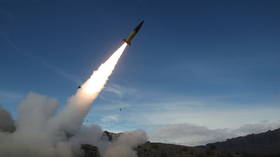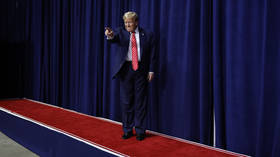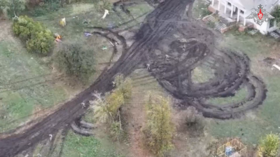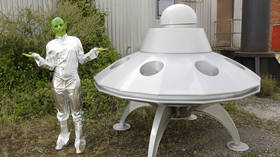When the city sleeps... the drones awaken: FAA’s new drone rules to allow commercial operators to fly at night
US authorities have issued new rules for the use of drones, allowing operators to fly over populated areas at night, including for package deliveries, but some were less than enthused by the idea.
The Federal Aviation Administration (FAA) announced the new guidelines on Monday, aimed to “address safety and security concerns” over the unmanned vehicles and “make way for the further integration of drones into our airspace,” FAA administrator Steve Dickson said, adding that the rules “get us closer to the day when we will more routinely see drone operations such as the delivery of packages.”
.@USDOT’s FAA has issued final rules that will require Remote ID of drones, and can enable operations of small drones over people and at night. These rules will accelerate the safe integration of drones into our nation’s airspace. Learn more at https://t.co/NSZQW5iv8u. #RemoteIDpic.twitter.com/Ay7hNGc6rq
— The FAA ✈️ (@FAANews) December 28, 2020
Most of the major rule changes pertain to the use of drones at night, particularly when they are to fly over people on the ground, as well as remote ID requirements. While drones will now be permitted to fly after dark under certain conditions – laying the ground for nighttime package deliveries by the likes of Amazon – operators will soon be required to attach a “remote ID broadcast module” to any craft weighing more than 0.55 pounds (0.25kg).
Though the previous framework only required drones to be labeled with a registration number, the new rules will force operators to broadcast not only the location of the vehicle, but also their own location on the ground, allowing law enforcement to keep tabs on who is flying what at any given time.
“Remote ID provides identification of drones in flight as well as the location of their control stations, providing crucial information to our national security agencies and law enforcement partners, and other officials charged with ensuring public safety,” the FAA said in its press release.
Also on rt.com World’s richest man, who has history of working with the CIA, gets official approval to unleash Amazon drones on the USThe remote ID requirement will come into force in 2022 for new drones, while existing craft will have to be retrofitted with the broadcasting tech by 2023. The rules apply to commercial operators as much as they do recreational pilots, even those flying indoors.
The new rules will likely be a boon to e-commerce firms and companies involved in package delivery, opening up US airspace for round-the-clock parcel drop-offs.
Not everybody was excited about the concept – once confined to science fiction – becoming reality, with some commenters arguing that the drones will have to be equipped with lights during their nocturnal excursions and may disturb citizens peacefully sleeping below with intrusive humming noises.
Hope everyone’s stoked for having drones that sound like bee swarms with ultra-bright lights buzzing up and down their streets all night!
— LoudGovTeacher (@LoudGovTeacher) December 29, 2020
Others have sounded privacy concerns. “Drones flying above you when you walk or drive, drones with cameras flying outside all the windows of your home at night. Great! Seems reasonable, what could possibly go wrong?” another observer tweeted.
Drones flying above you when you walk or drive, drones with cameras flying outside all the windows of your home at night. Great! Seems reasonable, what could possibly go wrong? 🤪 Time to start target practice
— Margarita (@moinqueens) December 29, 2020
The newly released guidelines did not sit well with hobbyists and those flying for leisure, who took to the web to blast the FAA framework, one deeming it “another nail in the coffin” for small drone operators.
“This makes it cost prohibitive for the small hobby/fun flier,” the commenter went on, adding “retrofitting is costly” and that the “FAA took the fun away.”
This isn’t fair to recreational pilots AT ALL, plus my cost of operations just went up. Obviously designed to push the little guys out. Not happy FAA!!!
— Ken (@Ken43055452) December 28, 2020
I'd also like to add that the rule says that my drone is now illegal to fly on my own property, but Amazon can fly their drones on my property...yeah try it.
— Leon Palnau (@LeonPalnau) December 28, 2020
Others noted a lack of clarity in the guidelines, some asking how the rules would apply to their individual case, while another demanded to know whether “anyone” would have access to the ID broadcasts, “or just police?”
This was done to benefit companies like Amazon while making it harder for small operators. And who are these additional authorities that can demand to see my license? Any idiotic that walks by? Will everyone be able to locate the drone operator with this ID? Or just police, etc?
— real Guy Fawkes (@AltFawkes) December 28, 2020
FAA Part 107 #Drone people: What the heck does this new rules update mean for you and me? Restrictions will ease, but we have to buy a new drone or attach some kind of transponder? https://t.co/FnYBbiIe9v
— David Ryder (@davidmryder) December 29, 2020
Despite the protests, some self-identified operators said they breathed a “sigh of relief” after the new rules were announced, given that the FAA previously mulled a requirement that would have forced pilots to broadcast their drones’ IDs to an internet network. The framework announced on Monday contains no such requirement.
Final rules for Remote ID of Drones were just released. We can all breathe a sigh of relief, NO Network requirements!! Seems like a very reasonable compromise from the FAA that will make the hobby safer for everyone. I'll have a full clip covering the changes posted this week. pic.twitter.com/azYOeL79aX
— Drone Valley (@DroneValley1) December 28, 2020
Over the summer, the FAA gave the green light to e-retailer giant Amazon to operate its drones beyond pilots’ “visual line of sight,” clearing the way for a fully “autonomous” delivery service, with the company ultimately aiming at 30-minute drop-off times for online orders. Before a full-scale roll-out, however, initial deliveries were restricted to low-population density areas, and only for packages five pounds or lighter. The United Postal Service and Wing – owned by Google’s parent firm, Alphabet – have similarly secured FAA approval for their own drone deliveries.
Like this story? Share it with a friend!














